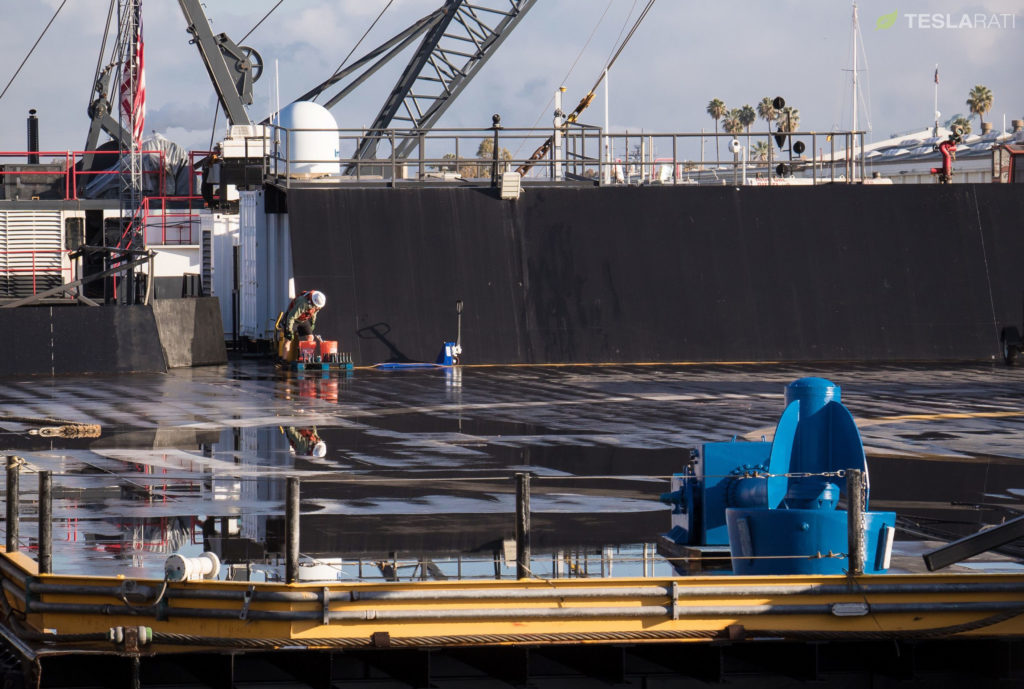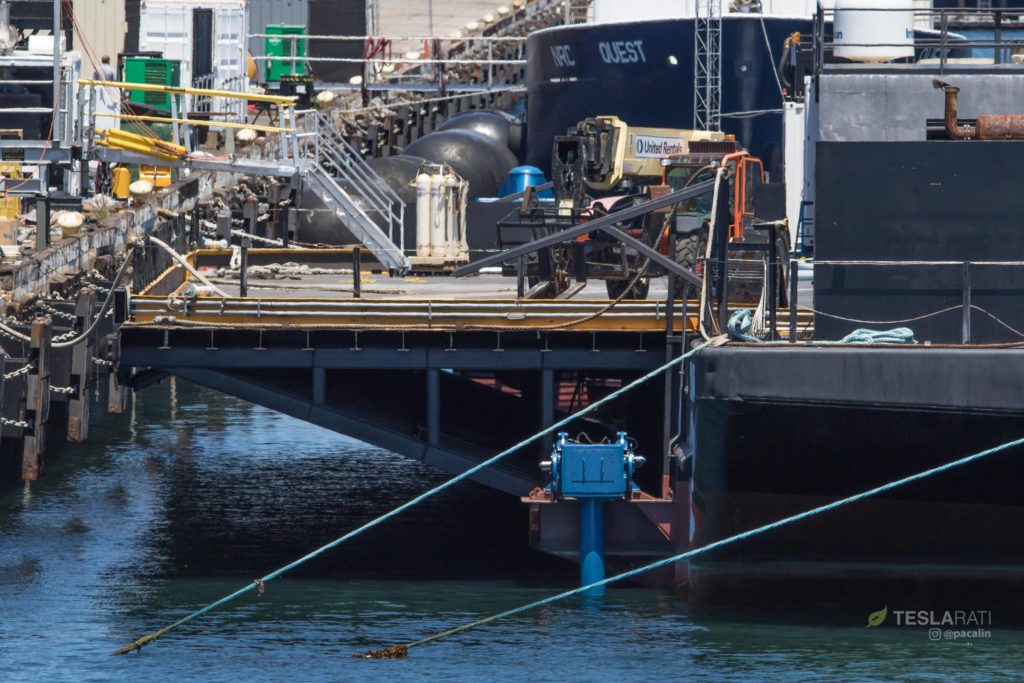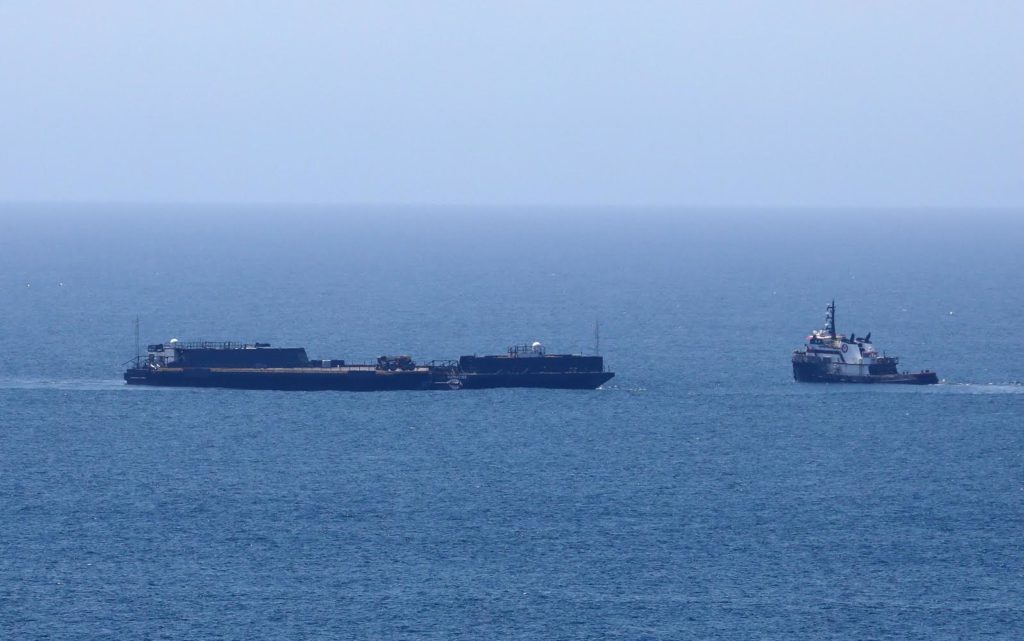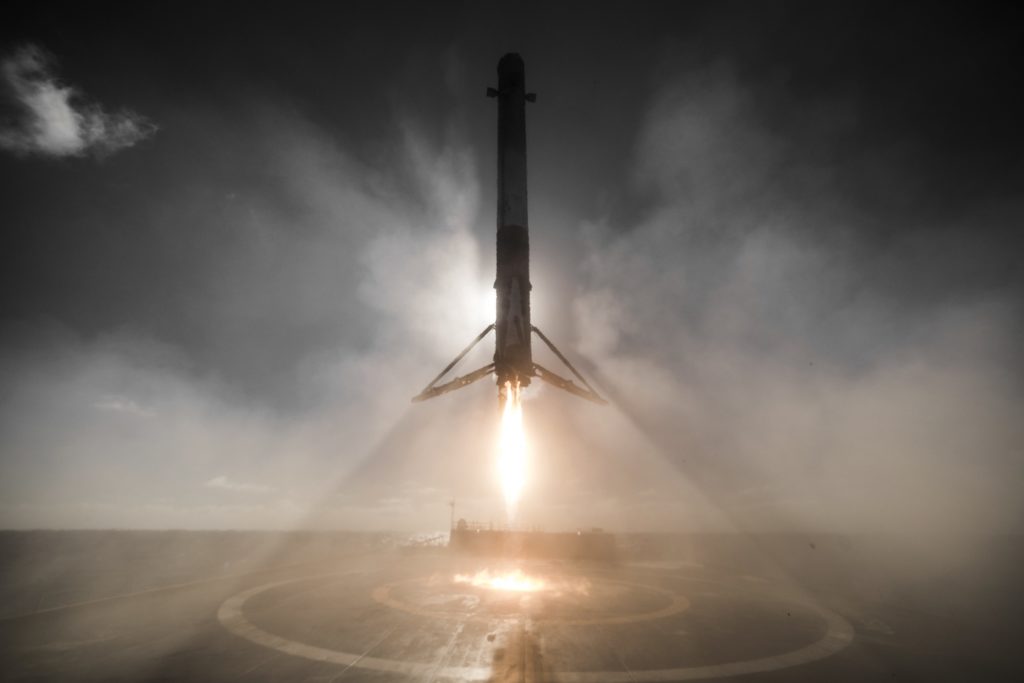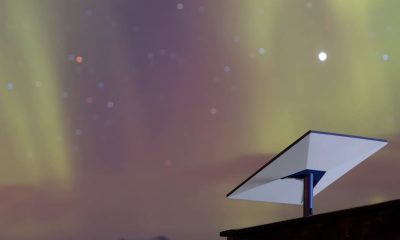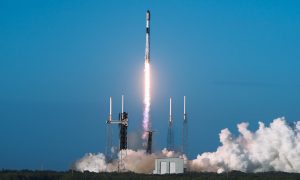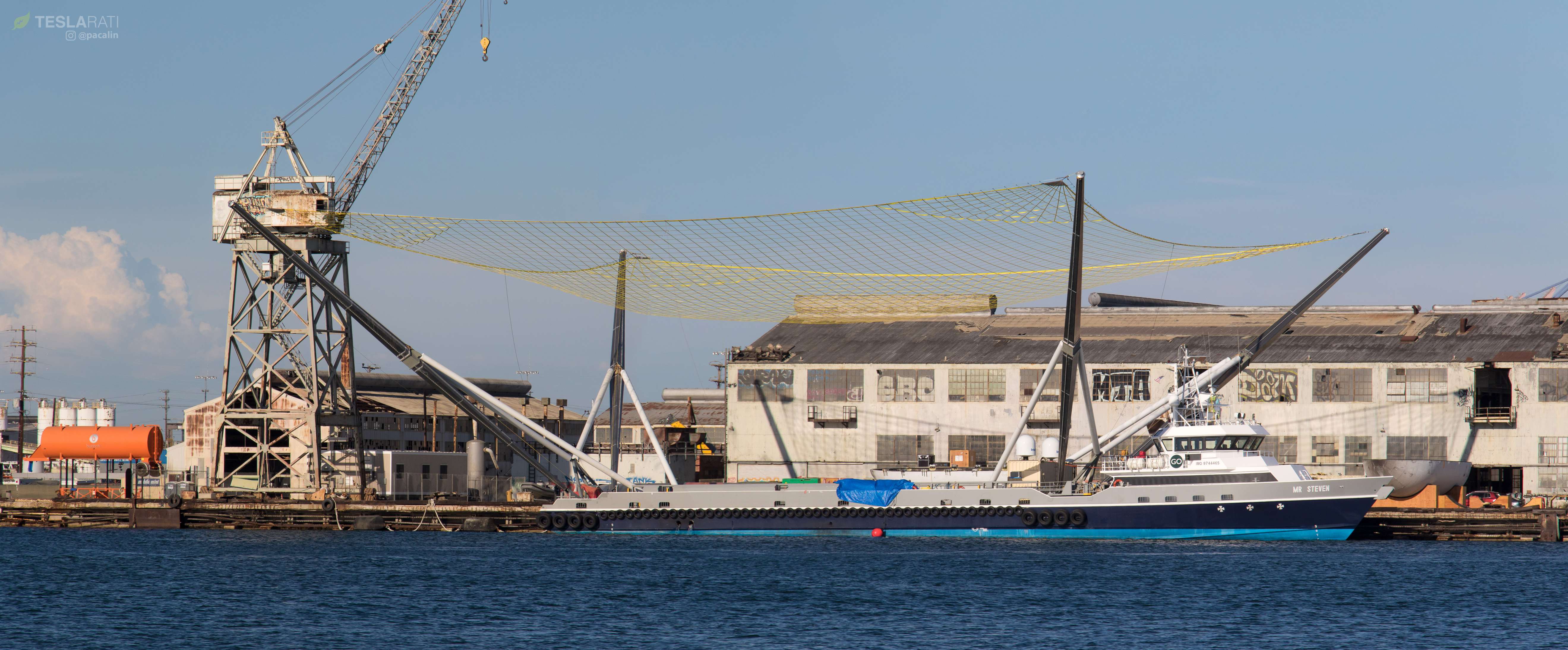

News
SpaceX’s Pacific rocket recovery fleet heads to sea for Western Block 5 debut
SpaceX drone ship Just Read The Instructions was spotted by Teslarati photographer Pauline Acalin departing Port of Los Angeles on the evening of July 22, while fairing catcher Mr Steven completed final checkouts and full installation of his massive new net, hopefully just days away from the first successful fairing catch. Their call to action, Iridium NEXT-7, is scheduled to launch NET 04:39 PDT/11:39 UTC, July 25th.
Over the course of July, both vessels have been undergoing significant maintenance and upgrades. Mr Steven’s was perhaps the most extreme – his original arm and net apparatus was removed in its entirety and replaced with a massively upgraded system of arms, booms, and a brand new net, well and truly expanding the vessel’s catching area by a factor of four.
With a new net and arm span stretching at least 60 meters by 60 meters, Mr Steven’s improved fairing catching mechanism is now almost the same size as the landing area aboard SpaceX’s two autonomous spaceport drone ships – roughly 200ft x 300ft (60m x 90m). While presumably a pure coincidence, the size parallels apparently necessary to recover two very different components of Falcon 9 – the booster rocket and the payload fairings – is rather satisfying.
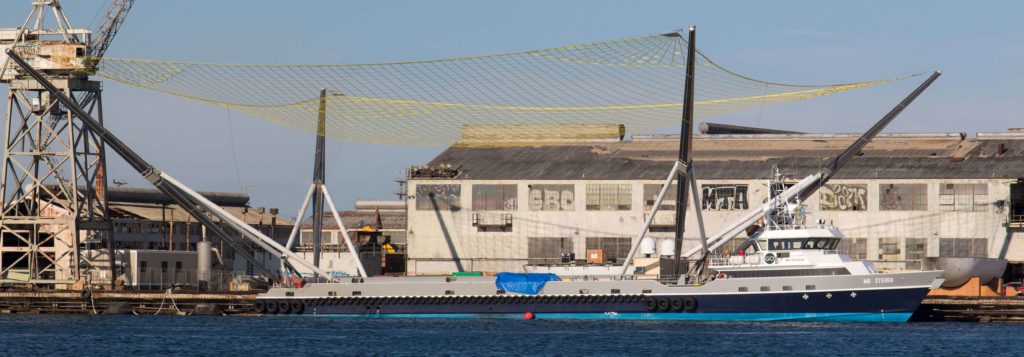
A last hurrah?
Intriguingly, ASDS Just Read The Instructions has stoically remained at SpaceX’s Port of San Pedro, CA berth for more than nine months, wholly unused despite the fact that the company has completed four additional missions since its last tasked booster recovery (October 2017, Iridium-3). It’s not a coincidence that all four of those Vandenberg AFB missions featured boosters that had already successfully launched and landed once before – SpaceX made a habit over the last four months of intentionally expending Falcon 9 boosters after their second missions, even when the launch conditions would allow for booster recovery.
This mission will thankfully bring an end to that understandable but still-painful practice, thanks to Iridium-7’s new Block 5 booster, B1048. Many of the months JRTI spent at berth were without the pod thrusters the drone ship needs to keep itself at the proper landing point once at sea, but JRTI departed the port with a full complement of four blue thrusters on the evening of July 22. However, it’s unclear how much SpaceX will need the vessel within just a month or two from today.
- A SpaceX technician works aboard the rain-soaked drone ship Just Read The Instructions, March 2018. (Pauline Acalin)
- More recently, all four thrusters were installed and tested both while berthed and at sea. May 11. (Pauline Acalin)
- JRTI captured conducting sea-trials by photographer Chuck Bennett. (Instagram, @chuckbennett)
At long last, SpaceX’s planned, built, and now-patiently-waiting West Coast landing zone is finally finished, permitted, and in the green to begin supporting Falcon 9 return-to-launch-site (RTLS) recoveries at Vandenberg Air Force Base. Effectively a basic copy of SpaceX’s now well-worn landing zone pair in Cape Canaveral, Florida, the company’s VAFB LZ-1 has been hinted at in two FCC launch permits for launches as early as the first and last weeks of September. Aside from Iridium launches, of which just one will remain after Iridium-7, nearly all of SpaceX’s West Coast launches are for fairly lightweight payloads that should easily allow Falcon 9 RTLS recoveries.
- Iridium-1’s successful and scenic landing on Pacific drone ship JRTI, January 2017. This could be an increasingly rare occurrence in the Pacific, thanks to SpaceX’s new land-based landing zone. (SpaceX)
- SpaceX’s West Coast landing zone is preparing for its debut, currently NET October 6th 2018. (Pauline Acalin/Teslarati)
Environmental conditions mean that JRTI will still be needed regularly for a handful of months (March through June) to avoid disrupting baby seals (pups, technically), but the vessel’s recovery efforts this week may be one of the last ‘off-season’ examples for months or even years to come. On the plus side, RTLS recovery at SpaceX’s VAFB landing zone will be an absolute dream for recovery technicians, as the LZ is directly beside the launch pad and hangar, where recovered Block 5 boosters can likely be refurbished or at least easily packaged and shipped to the Hawthorne factory.
For more sneak peeks and exclusive behind-the-scenes footage of SpaceX’s rocket recovery fleet, including drone ship Just Read The Instructions, be sure to subscribe to our exclusive membership program!
News
Tesla cleared in Canada EV rebate investigation
Tesla has been cleared in an investigation into the company’s staggering number of EV rebate claims in Canada in January.
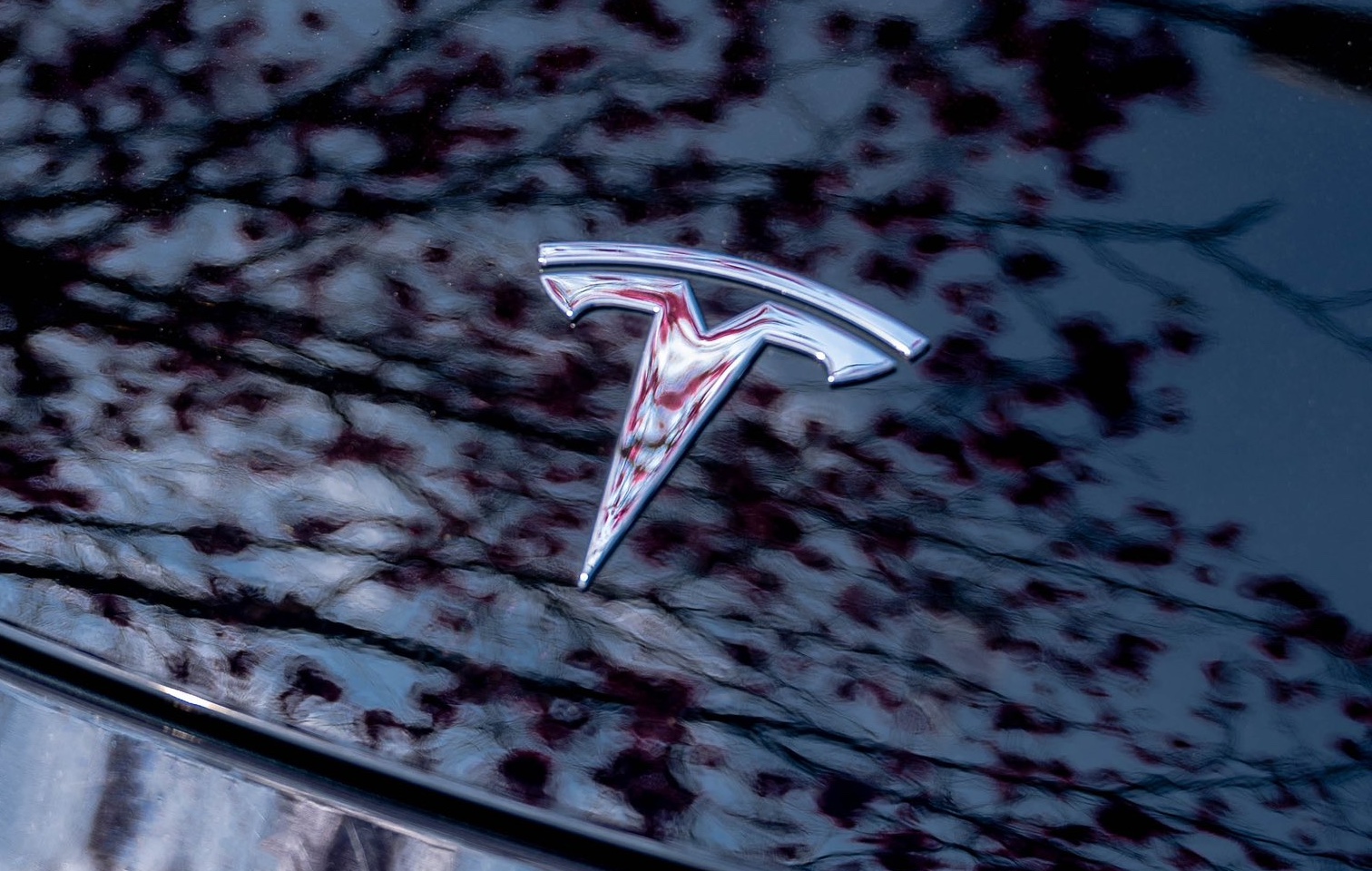
Canadian officials have cleared Tesla following an investigation into a large number of claims submitted to the country’s electric vehicle (EV) rebates earlier this year.
Transport Canada has ruled that there was no evidence of fraud after Tesla submitted 8,653 EV rebate claims for the country’s Incentives for Zero-Emission Vehicles (iZEV) program, as detailed in a report on Friday from The Globe and Mail. Despite the huge number of claims, Canadian authorities have found that the figure represented vehicles that had been delivered prior to the submission deadline for the program.
According to Transport Minister Chrystia Freeland, the claims “were determined to legitimately represent cars sold before January 12,” which was the final day for OEMs to submit these claims before the government suspended the program.
Upon initial reporting of the Tesla claims submitted in January, it was estimated that they were valued at around $43 million. In March, Freeland and Transport Canada opened the investigation into Tesla, noting that they would be freezing the rebate payments until the claims were found to be valid.
READ MORE ON ELECTRIC VEHICLES: EVs getting cleaner more quickly than expected in Europe: study
Huw Williams, Canadian Automobile Dealers Association Public Affairs Director, accepted the results of the investigation, while also questioning how Tesla knew to submit the claims that weekend, just before the program ran out.
“I think there’s a larger question as to how Tesla knew to run those through on that weekend,” Williams said. “It doesn’t appear to me that we have an investigation into any communication between Transport Canada and Tesla, between officials who may have shared information inappropriately.”
Tesla sales have been down in Canada for the first half of this year, amidst turmoil between the country and the Trump administration’s tariffs. Although Elon Musk has since stepped back from his role with the administration, a number of companies and officials in Canada were calling for a boycott of Tesla’s vehicles earlier this year, due in part to his association with Trump.
News
Tesla Semis to get 18 new Megachargers at this PepsiCo plant
PepsiCo is set to add more Tesla Semi Megachargers, this time at a facility in North Carolina.
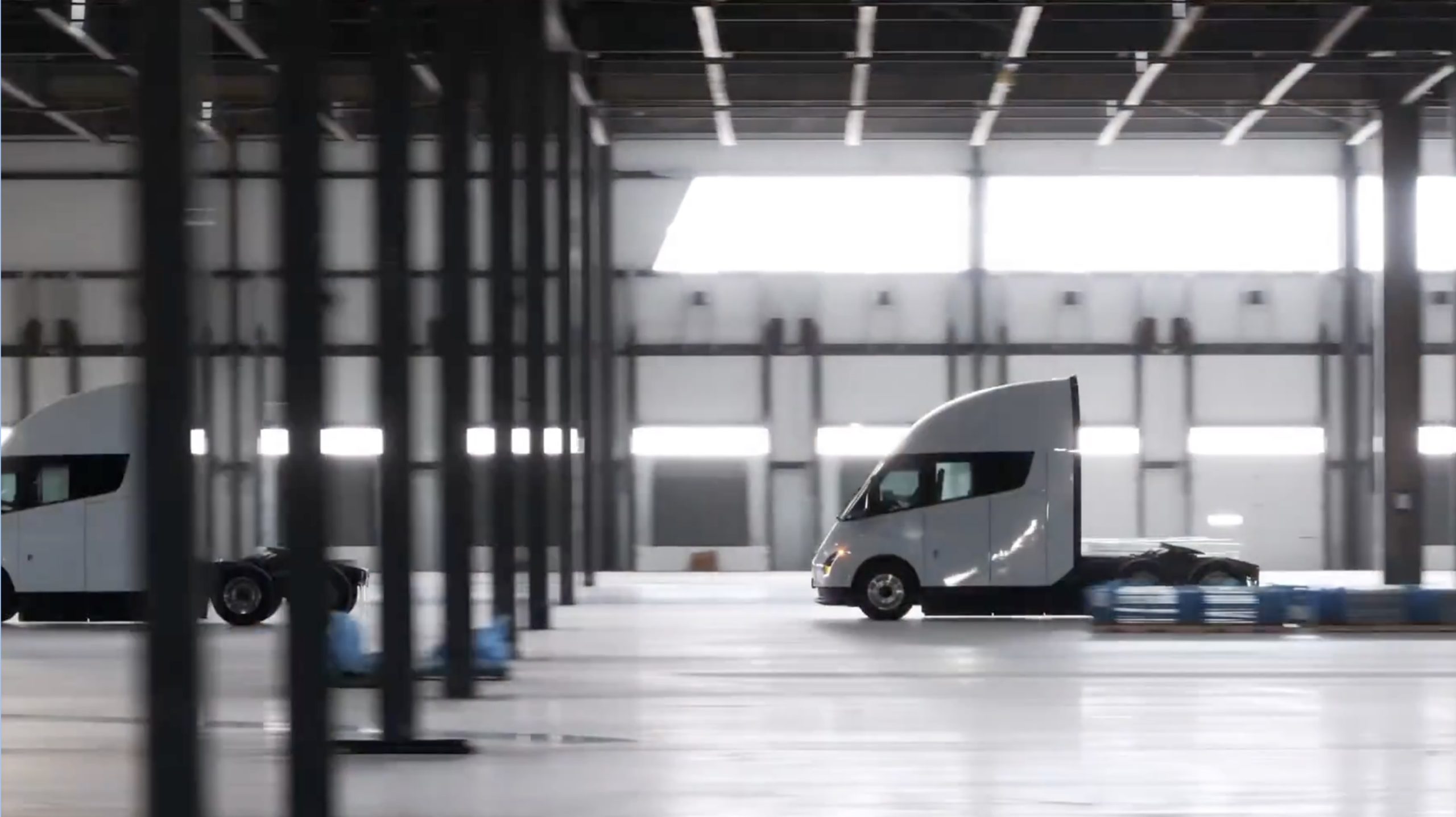
Tesla partner PepsiCo is set to build new Semi charging stations at one of its manufacturing sites, as revealed in new permitting plans shared this week.
On Friday, Tesla charging station scout MarcoRP shared plans on X for 18 Semi Megacharging stalls at PepsiCo’s facility in Charlotte, North Carolina, coming as the latest update plans for the company’s increasingly electrified fleet. The stalls are set to be built side by side, along with three Tesla Megapack grid-scale battery systems.
The plans also note the faster charging speeds for the chargers, which can charge the Class 8 Semi at speeds of up to 1MW. Tesla says that the speed can charge the Semi back to roughly 70 percent in around 30 minutes.
You can see the site plans for the PepsiCo North Carolina Megacharger below.
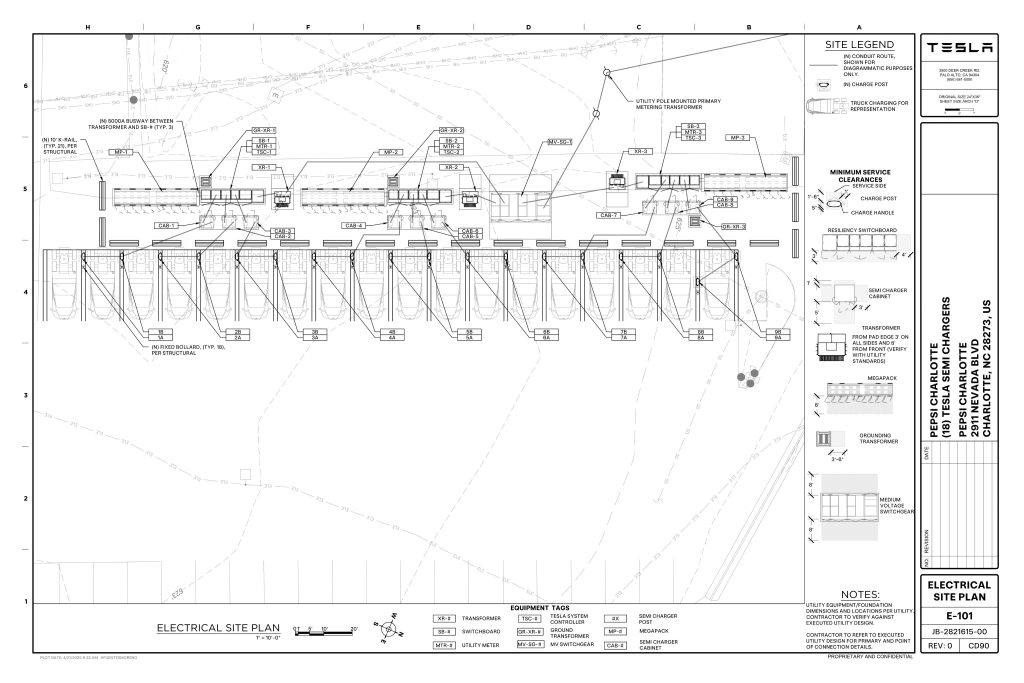
Credit: PepsiCo (via MarcoRPi1 on X)
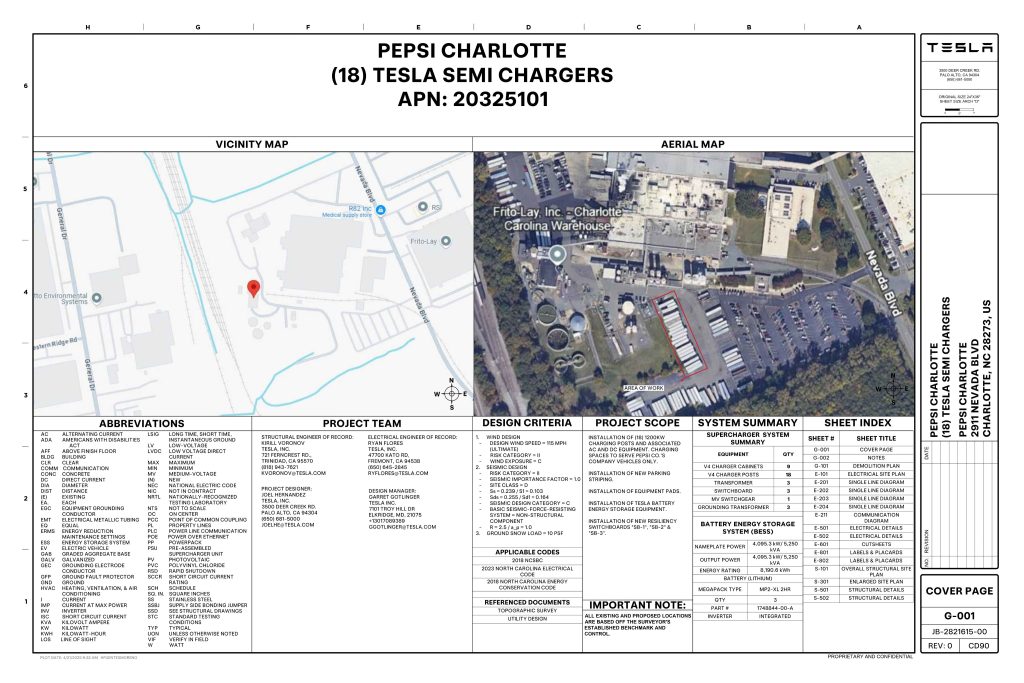
Credit: PepsiCo (via MarcoRPi1 on X)
READ MORE ON THE TESLA SEMI: Tesla to build Semi Megacharger station in Southern California
PepsiCo’s Tesla Semi fleet, other Megachargers, and initial tests and deliveries
PepsiCo was the first external customer to take delivery of Tesla’s Semis back in 2023, starting with just an initial order of 15. Since then, the company has continued to expand the fleet, recently taking delivery of an additional 50 units in California. The PepsiCo fleet was up to around 86 units as of last year, according to statements from Semi Senior Manager Dan Priestley.
Additionally, the company has similar Megachargers at its facilities in Modesto, Sacramento, and Fresno, California, and Tesla also submitted plans for approval to build 12 new Megacharging stalls in Los Angeles County.
Over the past couple of years, Tesla has also been delivering the electric Class 8 units to a number of other companies for pilot programs, and Priestley shared some results from PepsiCo’s initial Semi tests last year. Notably, the executive spoke with a handful of PepsiCo workers who said they really liked the Semi and wouldn’t plan on going back to diesel trucks.
The company is also nearing completion of a higher-volume Semi plant at its Gigafactory in Nevada, which is expected to eventually have an annual production capacity of 50,000 Semi units.
Tesla executive teases plan to further electrify supply chain
News
Tesla sales soar in Norway with new Model Y leading the charge
Tesla recorded a 54% year-over-year jump in new vehicle registrations in June.
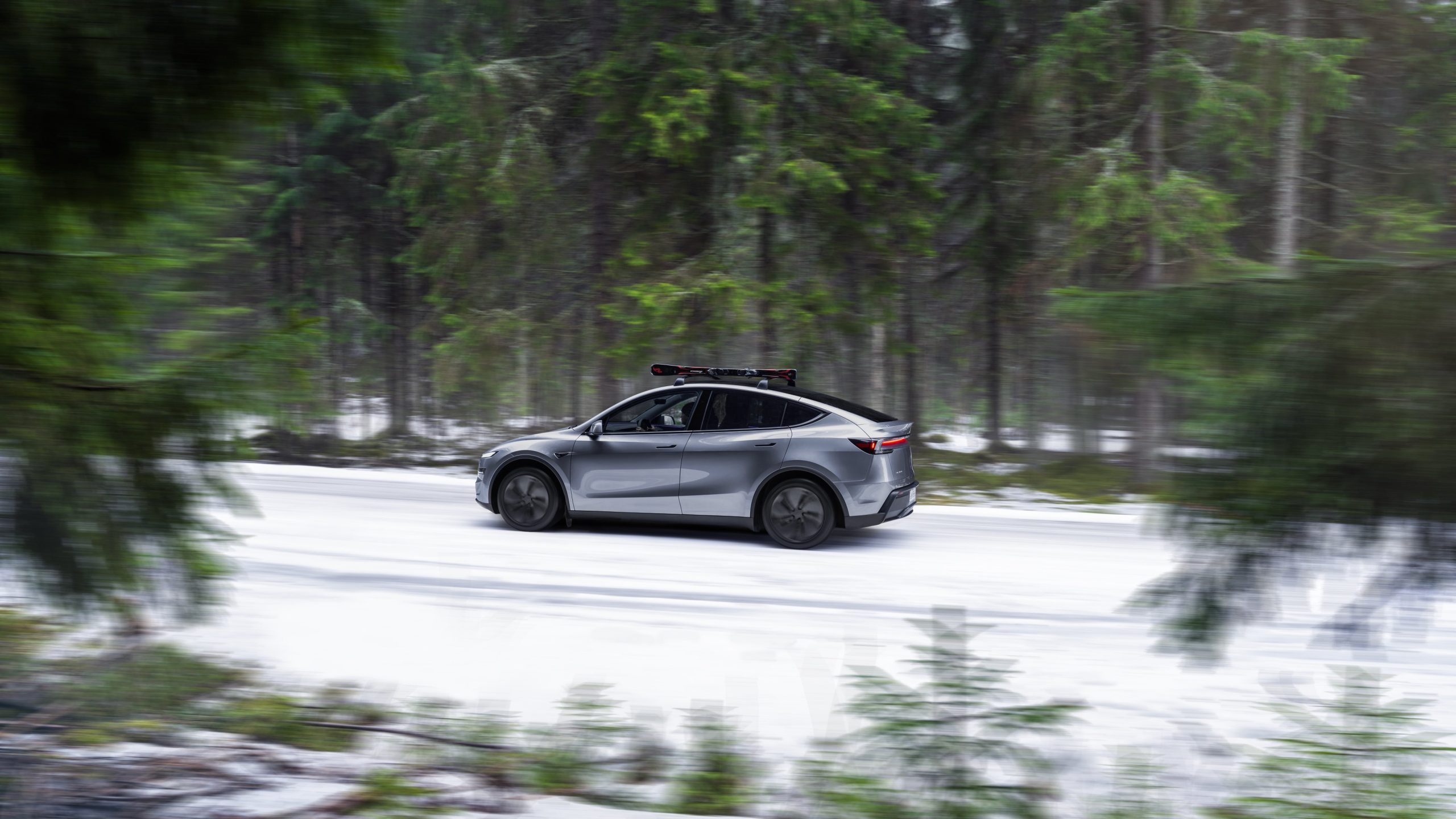
Tesla is seeing strong momentum in Norway, with sales of the new Model Y helping the company maintain dominance in one of the world’s most electric vehicle-friendly markets.
Model Y upgrades and consumer preferences
According to the Norwegian Road Federation (OFV), Tesla recorded a 54% year-over-year jump in new vehicle registrations in June. The Model Y led the charge, posting a 115% increase compared to the same period last year. Tesla Norway’s growth was even more notable in May, with sales surging a whopping 213%, as noted in a CNBC report.
Christina Bu, secretary general of the Norwegian EV Association (NEVA), stated that Tesla’s strong market performance was partly due to the updated Model Y, which is really just a good car, period.
“I think it just has to do with the fact that they deliver a car which has quite a lot of value for money and is what Norwegians need. What Norwegians need, a large luggage space, all wheel drive, and a tow hitch, high ground clearance as well. In addition, quite good digital solutions which people have gotten used to, and also a charging network,” she said.
Tesla in Europe
Tesla’s success in Norway is supported by long-standing government incentives for EV adoption, including exemptions from VAT, road toll discounts, and access to bus lanes. Public and home charging infrastructure is also widely available, making the EV ownership experience in the country very convenient.
Tesla’s performance in Europe is still a mixed bag, with markets like Germany and France still seeing declines in recent months. In areas such as Norway, Spain, and Portugal, however, Tesla’s new car registrations are rising. Spain’s sales rose 61% and Portugal’s sales rose 7% last month. This suggests that regional demand may be stabilizing or rebounding in pockets of Europe.
-

 Elon Musk2 weeks ago
Elon Musk2 weeks agoTesla investors will be shocked by Jim Cramer’s latest assessment
-

 Elon Musk2 days ago
Elon Musk2 days agoxAI launches Grok 4 with new $300/month SuperGrok Heavy subscription
-

 Elon Musk4 days ago
Elon Musk4 days agoElon Musk confirms Grok 4 launch on July 9 with livestream event
-

 News1 week ago
News1 week agoTesla Model 3 ranks as the safest new car in Europe for 2025, per Euro NCAP tests
-

 Elon Musk2 weeks ago
Elon Musk2 weeks agoA Tesla just delivered itself to a customer autonomously, Elon Musk confirms
-

 Elon Musk1 week ago
Elon Musk1 week agoxAI’s Memphis data center receives air permit despite community criticism
-

 News2 weeks ago
News2 weeks agoXiaomi CEO congratulates Tesla on first FSD delivery: “We have to continue learning!”
-

 Investor's Corner2 weeks ago
Investor's Corner2 weeks agoTesla gets $475 price target from Benchmark amid initial Robotaxi rollout

